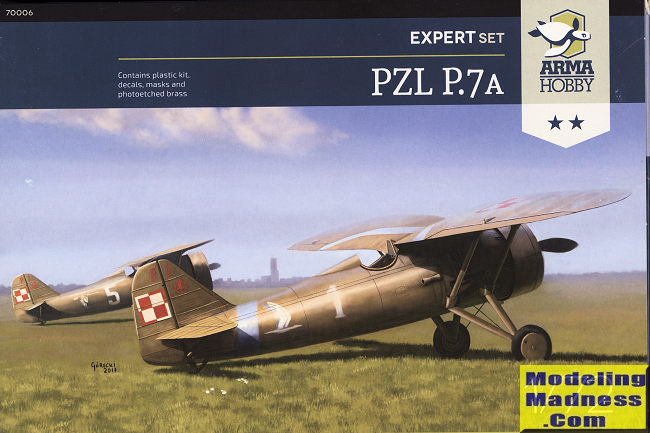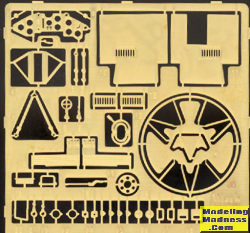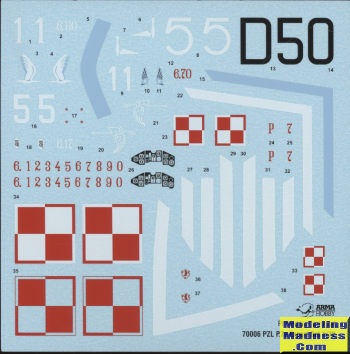
Arma Hobby 1/72 PZL P.7a
| KIT #: | 70006 |
| PRICE: | $18.99 |
| DECALS: | Two options |
| REVIEWER: | Scott Van Aken |
| NOTES: | Includes photo etch parts. |

| HISTORY |
The PZL P.7a entered service in spring 1933, replacing PWS-A (licence Avia BH-33) and PWS-10 fighters. Consequently, the Polish Air Force became the world's first air force entirely equipped with all-metal monococque fighters. When the P.7 entered service, it was a modern fighter, comparable to or better than contemporary designs, but due to rapid progress in an aircraft technology, it became totally obsolete by 1939. From 1935, in most combat units the P.7 was replaced by the PZL P.11, which was only slightly more modern. The P.7as were then moved to air schools.
At the outbreak of World War II on 1 September 1939, the Polish Air Force still had 30 PZL P.7a fighters in combat units. A further 40 were in air schools, 35 in reserve or repairs – a total of 106 available aircraft. The P.7as were used in three squadrons, each with 10 aircraft. The 123rd Squadron was in the Pursuit Brigade, deployed around Warsaw, the 151st and the 162nd Squadrons were assigned to land Armies. Despite being obsolete, they took part in the defence of the country during the German Invasion of Poland. Apart from combat units, at least 18 P.7a fighters were mobilized in units improvised at air bases in Dęblin and Ułęż.
Although the P.7 had better manoeuvrability than their German opponents and could operate from short fields (150 m to start), even rough ones, almost all the German aircraft were faster than the P.7a. Furthermore, the Polish aircraft and their engines were worn out from intensive service use. Their armament was also insufficient - only two Vickers machine guns in most aircraft, which had a tendency to jam (only from aircraft number 6.109 they were replaced with better PWU FK wz.33). For these reasons, the pilots flying the P.7a claimed shooting down only seven German aircraft (two He 111s, two Do 17s, one Hs 126 and two Bf 110s), suffering combat losses of 22 aircraft. An improvised task force of P.7a aircraft from units at air bases was rather to confuse and disturb the German bombing raids with their aggressive presence, than to shoot down bombers.
Most of the P.7a fighters were destroyed in 1939, in combat or on the ground, some dozen were withdrawn to Romania, but not used in combat there. Some captured P.7s were used by the Germans for training. Several aircraft were captured by the Soviets (exact number is not known) and were next assigned for training.
| THE KIT |
 This
isn't the first 1/72 P.7a kit ever done, but it is a very good one. It is short
run as it relies on photo etch for a lot of d
This
isn't the first 1/72 P.7a kit ever done, but it is a very good one. It is short
run as it relies on photo etch for a lot of d etail
parts. It also includes a set of canopy and wheel masks, which is something that
adds value. The photo etch covers things like the instrument panel (for which an
acetate sheet is provided), a windscreen frame (again, acetate is provided for
the panes), various vents (or conversely the entire surrounding panel with the
vent), floor boards and a ton of smaller bits for the cockpit as well as for the
exterior of the aircraft, and that includes the large cowling brace. Some of
these bits are optional if you wish to use the plastic alternatives.
etail
parts. It also includes a set of canopy and wheel masks, which is something that
adds value. The photo etch covers things like the instrument panel (for which an
acetate sheet is provided), a windscreen frame (again, acetate is provided for
the panes), various vents (or conversely the entire surrounding panel with the
vent), floor boards and a ton of smaller bits for the cockpit as well as for the
exterior of the aircraft, and that includes the large cowling brace. Some of
these bits are optional if you wish to use the plastic alternatives.
Despite some flash, most notably on the fin/rudder, the molding is excellent. The fuselage interior has nice detail and the underside detailing on the wing is properly raised. I also found a few sink areas on some thick bit. Nothing out of the ordinary for this type of kit.
 As is often
the case with short run kits, there are quite a few small parts so you will be
spending more than the usual time cleaning and assembling bits. The exhaust
stacks, for instance, are all separate items. Even the plastic bits in the
cockpit are rather numerous. Struts have positive locator holes and
the prop has
separate blades with large slots in the spinner to accept them. The kit also comes with two clear plastic windscreens. One is for the P.7 and the other for the P.11 as one option has the later windscreen. Those who don't want to as
As is often
the case with short run kits, there are quite a few small parts so you will be
spending more than the usual time cleaning and assembling bits. The exhaust
stacks, for instance, are all separate items. Even the plastic bits in the
cockpit are rather numerous. Struts have positive locator holes and
the prop has
separate blades with large slots in the spinner to accept them. The kit also comes with two clear plastic windscreens. One is for the P.7 and the other for the P.11 as one option has the later windscreen. Those who don't want to as semble their windscreen with p.e. and acetate will undoubtedly use this option.
semble their windscreen with p.e. and acetate will undoubtedly use this option.
Instructions are well drawn and provide detail images. They don't flow all that well as one page will show you putting bits on the outside of a completed fuselage and the next will show the insertion of the cockpit between the two separate halves. Those who buy these kinds of kits will have no issue sorting things out, but one does have to beware. The kit provides four markings options, all in an overall khaki brown. The decals look great and include instrument panel decals for those who don't want to fuss with the acetate sheet. Instructions include a full color painting guide with FS 595 and HTK paint references.
| CONCLUSIONS |
This won't be a quick build and is very much only for experienced modelers, thanks to all the tiny parts. However, if you have built any of the MPM/Azur P.11c kits, this one will not be a problem. I realize that PAF aircraft don't have a huge following outside the home country, but this can easily be made into a superb little model.
| REFERENCES |
https://en.wikipedia.org/wiki/PZL_P.7
February 2018 Copyright ModelingMadness.com. All rights reserved.
If you would like your product reviewed fairly and fairly quickly, please
contact
the editor or see other details in the
Note to
Contributors. Back to the Main Page
Back to the Review
Index Page
Back to the Previews Index Page